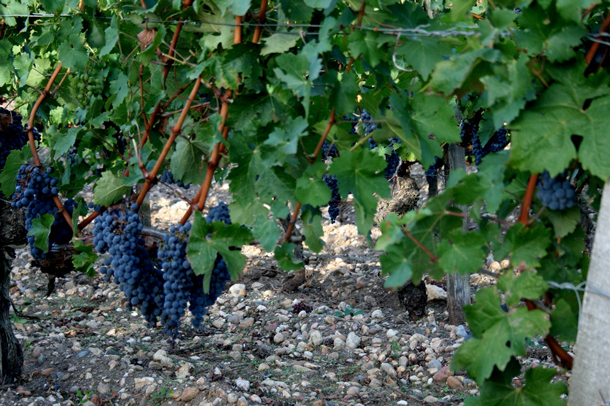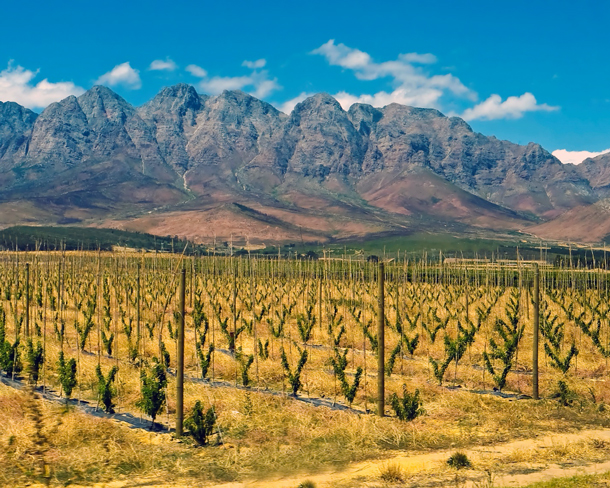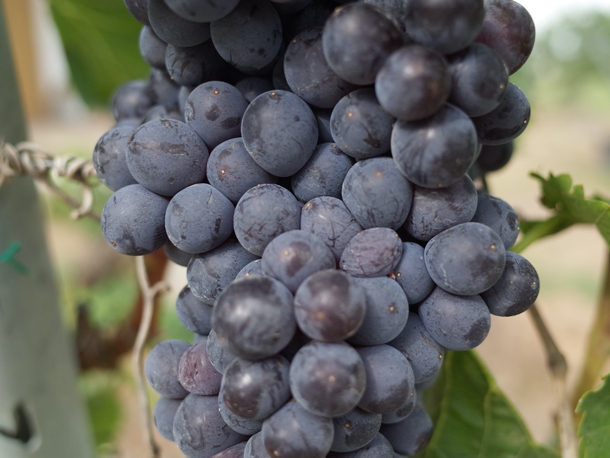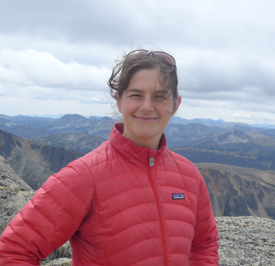Wine Regions Struggle with Climate Change
Air Date: Week of February 7, 2020

Chile is a major producer of Cabernet Sauvignon which is usually aged in American oak adding hints of vanilla, spice, and tobacco. (Photo: Fer Quintana, Flickr, CC BY-SA 2.0)
As the climate changes, the wine-growing regions of the world are shifting location. Professor Elizabeth Wolkovitch of the University of British Columbia joins Host Bobby Bascomb to talk about how viticulture will be impacted by climate change and how it can adapt.
Transcript
BASCOMB: Well, Valentine’s Day is just around the corner. For some that might mean a cozy table for two at a nice restaurant and a favorite bottle of wine. Whether it’s a dry cabernet or a fruity pinot noir, people can be passionate about their wine. The 2004 film Sideways was about a man named Miles with very strong opinions on wine. Here a friend is talking to Miles about how to behave as they head in on a double date.
JACK: And if they want to drink merlot, we’re drinking merlot.
MILES: No, if anyone orders merlot I’m leaving. I am not drinking any merlot!
JACK: Ok, ok relax Miles. Jesus, no merlot.

Bordeaux is a dark blue colored grape grown in the Bordeaux region of France. The wine itself is made up of a blend of at least two parts of cabernet sauvignon, merlot and cabernet franc. (Photo: Meghan Cole, Flickr, Bordeaux Chateau Smith, CC BY 2.0)
BASCOMB: Well, according to a recent study, the Miles of the world will have to be a bit more flexible about their wine preferences in the future. That’s because climate change is already wreaking havoc on what grapes can be grown where and the trend is only expected to get worse with time. In fact, a recent study found that roughly 85 percent of current wine producing areas will be lost, no longer able to grow grapes, if the world average temperature rises by 7 degrees Fahrenheit, a scenario scientists believe is possible if we don’t adequately address the climate crisis. For more I’m joined now by Elizabeth Wolkovich. She’s a Professor of forest and conservation sciences at the University of British Columbia. And lead author of the recent study published in the Proceedings of the National Academy of Sciences. Elizabeth Wolkovich, welcome to Living on Earth!
WOLKOVITCH: Thanks for having me. It's great to be here.
BASCOMB: In terms of the wine regions of the world, who are the biggest losers and winners when it comes to climate change?
WOLKOVITCH: Certainly what we see at a broad scale is that regions that are hot now, places like Italy, Spain, much of Australia, where they currently grow wine grapes right now, are already on the edge of which varieties they can choose. So they have a limited amount of diversity to consider planting in the future and that means that in our projections, which do look at just a slice of the diversity, we see those regions seeing major losses without significant gains. So upwards of 80%, or more of the current growing regions in those areas could be lost with warming. On the flip side, places that are cooler like the United Kingdom, Tasmania, New Zealand, the Pacific Northwest of the United States, those regions gain lots of opportunities to grow different wine grapes or more varieties of wine grapes. So roughly speaking, cooler regions growing wine grapes now are the winners, hotter regions are the losers, but it really depends on what places choose to do. So France, for example, where many of the most famous varieties come from sees balanced losses and gains. So we see that they will lose potentially 25% of their regions due to certain varieties that they grow now becoming less suitable, but they can grow later ripening varieties at about the same rate. So you wouldn't really predict major regions in France to go away based on these results.

South African wine was established by the Dutch East India company. Its most common types of grapes are cabernet sauvignon, merlot, shiraz and pilotage. (Photo: Jack Whites, Flickr, CC BY-ND 2.0)
BASCOMB: Is there anything they can do besides just growing different varieties of grapes? I mean, is there any other, you know, agricultural practices that would be useful, anything like that?
WOLKOVITCH: Yes, as with all agriculture, there are lots of different ways to modify a crop to try to deal with warming. So for wine grapes in particular, growers have been feeling climate change for decades now, many of them already have options that they use every year for the most part to deal with the warming. Across California most growers at this point use something called shade cloth that basically just takes some of the sunlight off the berries to try to reduce the local climate right next to the cluster, for example. Growers in California have also switched to micro misters, if they can afford it, so if you think of when you go to the grocery store, and you see those micro misters coming down on produce, people actually install those outside and it has a dramatic effect on the climate right around the plants so that can reduce temperatures. Growers can do other dramatic things like change rootstocks, so wine grapes are different on the bottom than on the top and they have options for trying to change within their vineyard where they grow things. So if they have a slope that's a bit cooler, they might start planting more there. So there's lots of options out there.
BASCOMB: And it sounds like those adaptations, I mean, they could be kind of expensive, you know, misters, and all of these things to introduce, I mean, that's not free and then at the same time, they're probably taking a hit to their bottom line, just in terms of their productivity in the, in the meantime; how do you expect, you know, the economics around growing wine to change in the future?
WOLKOVITCH: Yeah, the economics of growing crops in general and especially wine grapes is a billion dollar or more question right now. Certainly, it's really expensive to change a variety. It's not an easy solution, it's not a cheap solution and it has knock on effects once you've even changed the variety, you have to figure out how to harvest it figure out how to make great wine out of it and none of the solutions are cheap. So places that are large that have a lot of money have already started buying land in other places. Taittinger is a famous maker of champagne from Champagne, France, and they now own a sizable area of the United Kingdom that they believe will be ideal for making champagne wine grape varieties in the future. Major groups in Bordeaux own parts of China in the mountain region that they think will be high quality regions soon, climatically. And so I think the issue is none of the solutions to climate change adaptation for growers are ideal in terms of economics, the questions are which ones are even an option for most growers. Smaller growers really can't think about buying land somewhere else and continually changing what they do in terms of the geography. So even though changing varieties could be a huge economic hit, it might be the difference between continuing to grow wine grapes or not.

Grenache or Garnacha is one of the most common wine grapes and thrives in hot dry condition such as those found in Spain. (Photo: Francisco Martinez Arias Flickr, CC BY 2.0)
BASCOMB: Can it still be called champagne, if it's grown in England, doesn't it have to be from the Champagne region of France?
WOLKOVITCH: It can't legally be called champagne. So champagne usually contains three wine grape varieties for the most part, Chardonnay, Pinot Noir and Pinot Meunier. So you could say you are growing champagne varieties in another place, but you legally cannot call it champagne unless it comes from champagne.
BASCOMB: And I understand that climate change can also actually affect the alcohol content of wine. Is that right? And how does that work?
WOLKOVITCH: Yes, there is lots of evidence that alcohol content in wine has increased probably about a degree or more over the last several decades. So we used to drink wine that was maybe thirteen percent alcohol and it's possible nowadays to grab a bottle that's fifteen or fifteen-point-five percent, that's pretty high alcohol. With higher temperatures growers are harvesting earlier, when you harvest earlier, you basically have to harvest at higher sugar content. And that's just the functional way the berry works: hotter temperatures, more sugar, that sugar goes into the juice and that juice becomes higher alcohol, it's a simple process. And the higher alcohol is actually to the level where lots of growers are looking into de-alcoholizing processes.
BASCOMB: Wow.
WOLKOVITCH: So these can be complicated things where you run the grape juice through a machine to try to get some of the alcohol out. Or I've even heard of growers adding water or trying to do other manipulations to bring the alcohol content down. So it's definitely something that growers around the world are seeing and they're concerned about because they know at some point consumers don't want super high alcohol wine. It's harder to make a good high quality wine when it's that high in alcohol and certainly changing varieties is a way to get the alcohol down and growers know that. So the higher alcohol content comes from keeping the variety you're growing in a certain region there and having to harvest it earlier because it's gotten hotter. But if you shift to a later ripening, more heat tolerant variety, it's going to ripen towards the end of the season and we'll have a more natural sugar level that's much more appropriate to what we think of for wine sugar levels.
BASCOMB: As a consumer of wine, what can you do about this? I mean, it seems like an overwhelming problem.

Eizabeth M. Wolkovitch is an Associate Professor of Forest and Conservation Science at the University of British Columbia. (Photo Courtesy of Elizabeth M. Wolkovitch)
WOLKOVITCH: So as a consumer of wine, I think you have sort of immediate things you can do about how you purchase wine and then the much bigger issue of how much warming are we contributing to as a globe. So at the very local scale, depending on where you live, if you know the winemaker or the growers in your area, you can talk to them about how much warming they've experienced and what they're considering. Growers are often afraid to talk about how much warming they know they have in their vineyard and how they're adapting to it already because terroir, this important term that describes the wine growing region, its soil, its climate, its slope, all these things really come back to climate. And so they know if they admit that their climate is changing, they're saying their terroir is changing and they're, they're nervous to say that but they're interested in what consumers are willing to taste and to try. So as a consumer if you're buying blended wines more often or unusual varieties from a region, if you are more focused on flavor profiles you like over certain varieties. That's what growers want to hear. That's what allows them to make decisions about how they adapt and whether they change varieties. But I will say our research really shows that the biggest impact we can have on wine growing regions and wines we love is by limiting further warming. So adaptation potential works, it works at a three point six degree Fahrenheit warming event, fairly well saving half of the potential losses but it doesn't work that well at a seven point two degree Fahrenheit warming event. We end up losing well over half the current wine growing regions, even if growers make this huge adaptation choice to rapidly change varieties. And I should say at that seven point two degree warming event, which is what we're more or less headed towards by the end of the century, growers have to keep changing. So they don't just change varieties once in our models, they change every thirty or so years to new varieties. So it's a constant cost burden for them and it's unclear how many growers could really continue to do that over the long term.
BASCOMB: Elizabeth Wolkovitch is a professor at the University of British Columbia in forest and conservation sciences and lead author of this study. Thank you so much for taking this time with me.
WOLKOVITCH: Thanks.
Links
The Harvard Gazette | “As Climate Changes, So Will Wine Grapes”
Inhabitant | “How Climate Change Will Impact Wine”
Union of Concerned Scientists | “Climate Change and Wine - Is the Glass Half Full or Half Empty”
New York Times | “How Climate Change Impacts Wine”
Click here to read the study: “Diversity Buffers Wine Growing Regions from Climate Change Losses”
Living on Earth wants to hear from you!
Living on Earth
62 Calef Highway, Suite 212
Lee, NH 03861
Telephone: 617-287-4121
E-mail: comments@loe.org
Newsletter [Click here]
Donate to Living on Earth!
Living on Earth is an independent media program and relies entirely on contributions from listeners and institutions supporting public service. Please donate now to preserve an independent environmental voice.
NewsletterLiving on Earth offers a weekly delivery of the show's rundown to your mailbox. Sign up for our newsletter today!
 Sailors For The Sea: Be the change you want to sea.
Sailors For The Sea: Be the change you want to sea.
 The Grantham Foundation for the Protection of the Environment: Committed to protecting and improving the health of the global environment.
The Grantham Foundation for the Protection of the Environment: Committed to protecting and improving the health of the global environment.
 Contribute to Living on Earth and receive, as our gift to you, an archival print of one of Mark Seth Lender's extraordinary wildlife photographs. Follow the link to see Mark's current collection of photographs.
Contribute to Living on Earth and receive, as our gift to you, an archival print of one of Mark Seth Lender's extraordinary wildlife photographs. Follow the link to see Mark's current collection of photographs.
 Buy a signed copy of Mark Seth Lender's book Smeagull the Seagull & support Living on Earth
Buy a signed copy of Mark Seth Lender's book Smeagull the Seagull & support Living on Earth

